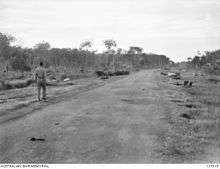Parit Sulong Massacre

On 23 January 1942, the Parit Sulong Massacre in Johor, Malaya (now Malaysia) was committed against Allied soldiers by members of the Imperial Guards Division of the Imperial Japanese Army. A few days earlier, the Allied troops had ambushed the Japanese near Gemas and blown up a bridge there.
Incident
During the Battle of Muar, members of both the Australian 8th Division and the 45th Indian Infantry Brigade were making a fighting withdrawal, when they became surrounded near the bridge at Parit Sulong. They fought the larger Japanese forces for two days, until they ran low on ammunition and food. Able-bodied soldiers were ordered to disperse into the jungle, the only way they could return to Allied lines. About 150 Australians and Indians were too seriously injured to move, and their only option was to surrender. Some accounts estimate that as many as 300 Allied troops were taken prisoner at Parit Sulong.
The Imperial Guards kicked and beat the wounded prisoners of war with their rifle butts. At least some of them were tied up with wire in the middle of the road and machine-gunned. The Japanese then poured petrol over the bodies, set them alight, and (in the words of Russell Braddon) "after their incineration...systematically run over, back and forwards, by Japanese driven trucks."[1] Anecdotal accounts by local people also reported POWs being tied together with wire and forced to stand on a bridge, before a Japanese soldier shot one of them, causing the rest to fall into the Simpang Kiri river and drown.
Aftermath

Lt Ben Hackney of the Australian 2/29th Battalion feigned death and managed to escape. He crawled through the countryside for six weeks with two broken legs, before he was recaptured.[2] Hackney survived internment in Japanese POW camps, and was part of the labour force on the notorious Burma Railway. He and two other survivors gave evidence regarding the massacre to Allied war crimes investigators.
The commander of the Imperial Guards, Lt Gen. Takuma Nishimura, was later in charge of occupation forces in eastern Singapore. He was indirectly involved in the Sook Ching massacre in Singapore. Nishimura retired from the Japanese army in 1942 and was made military Governor of Sumatra. Following the war, he was tried by a British military court in relation to the Sook Ching massacre. Nishimura received a life sentence, of which he served four years. As he returned to Japan, Nishimura was removed from a ship at Hong Kong, by Australian military police and charged in relation to the Parit Sulong massacre. Nishimura was taken to Manus Island in the Territory of New Guinea, where he faced an Australian military court. Evidence was presented stating that Nishimura had ordered the shootings at Parit Sulong and the destruction of bodies. He was convicted and executed by hanging on 11 June 1951.
In 1996, Australian journalist Ian Ward published Snaring the Other Tiger, which suggested that the Australian Army prosecutor, Captain James Godwin—a former Royal New Zealand Air Force pilot who had been ill-treated as a POW in Sumatra—had "manipulated" evidence to implicate Nishimura.[3] Ward states that Godwin took no action on the testimony of Lieutenant Fujita Seizaburo, who reportedly took responsibility for the Parit Sulong massacre. Fujita was not charged and his fate is unknown. Extensive research conducted by Professor Gregory Hadley and James Oglethorpe and published in the Journal of Military History in 2007 subsequently showed that the evidence that purported to indict James Godwin was a later fabrication created to further political causes in the 1990s.[4]
See also
Footnotes
- ↑ Russell Braddon, 1951, The Naked Island, Penguin Books, Melbourne, p. 101.
- ↑ Tony Stephens, "The killing field at The Bridge" (Sydney Morning Herald, 13 September 2004). Access date: 16 February 2007.
- ↑ Ian Ward, Snaring the Other Tiger (Media Masters Publishers, Singapore, 1996); Dictionary of New Zealand Biography, "Godwin, James Gowing 1923 - 1995". Access date: 16 February 2007
- ↑ MacKay's Betrayal: Solving the Mystery of the "Sado Island Prisoner-of-War Massacre" The Journal of Military History - Volume 71, Number 2, April 2007, pp. 441-464
References
- Braddon, Russell, 1951, The Naked Island, Penguin Books, Melbourne,
- Findlay, Iain, 1991, Savage Jungle – An Epic Struggle for Survival, Simon & Schuster, Sydney.
- MacKay's Betrayal: Solving the Mystery of the "Sado Island Prisoner-of-War Massacre" The Journal of Military History - Volume 71, Number 2, April 2007, pp. 441-464
- Mant, Gilbert, 1996, Massacre at Parit Sulong, Kangaroo Press, Kenthurst.
- Silver, Lynette, 2004, The Bridge at Parit Sulong – An Investigation of Mass Murder, The Watermark Press, Boorowa. ISBN 0-949284-65-3.
- Wigmore, Lionel, 1957, The Japanese Thrust – Australia in the War of 1939-1945, AWM, Canberra.
External links
- Bedi, Harchand Singh (2015). "The Game of Love: Battle of Malaya". sikhnet.com.